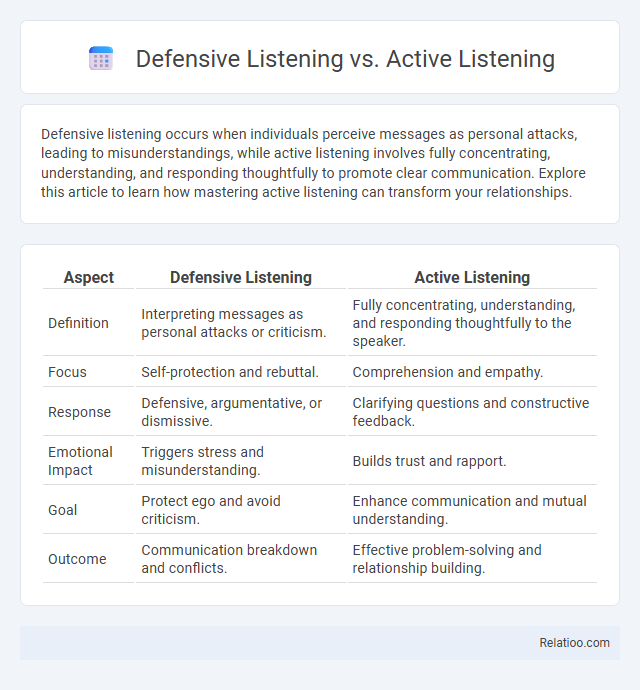Defensive listening occurs when individuals perceive messages as personal attacks, leading to misunderstandings, while active listening involves fully concentrating, understanding, and responding thoughtfully to promote clear communication. Explore this article to learn how mastering active listening can transform your relationships.
Table of Comparison
| Aspect | Defensive Listening | Active Listening |
|---|---|---|
| Definition | Interpreting messages as personal attacks or criticism. | Fully concentrating, understanding, and responding thoughtfully to the speaker. |
| Focus | Self-protection and rebuttal. | Comprehension and empathy. |
| Response | Defensive, argumentative, or dismissive. | Clarifying questions and constructive feedback. |
| Emotional Impact | Triggers stress and misunderstanding. | Builds trust and rapport. |
| Goal | Protect ego and avoid criticism. | Enhance communication and mutual understanding. |
| Outcome | Communication breakdown and conflicts. | Effective problem-solving and relationship building. |
Understanding Defensive Listening
Defensive listening occurs when a listener perceives comments as personal attacks or threats, leading to misunderstandings and hindered communication. Unlike active listening, which involves attentively processing and responding to the speaker's message with empathy and openness, defensive listening triggers emotional barriers that block effective information exchange. Understanding defensive listening is crucial in identifying communication breakdowns and fostering more responsive, trust-based interactions.
What is Active Listening?
Active listening involves fully concentrating, understanding, and responding thoughtfully to the speaker, promoting effective communication and reducing misunderstandings. Unlike defensive listening, where the listener perceives remarks as personal attacks, active listening requires openness and empathy to accurately interpret the message. This skill enhances interpersonal relationships by encouraging feedback, clarifying doubts, and demonstrating genuine interest in the conversation.
Key Differences Between Defensive and Active Listening
Defensive listening involves interpreting messages as personal attacks, leading to misunderstandings and conflict, whereas active listening requires fully concentrating, understanding, and responding thoughtfully to the speaker's message. Your communication improves significantly when practicing active listening, as it fosters empathy and open dialogue, unlike defensive listening which triggers emotional barriers. Key differences lie in the listener's mindset and response: defensive listeners protect themselves from perceived criticism, while active listeners seek clarity and connection.
Common Triggers of Defensive Listening
Common triggers of defensive listening include perceived personal attacks, criticism, or threats to self-esteem, which often cause you to react emotionally rather than listen objectively. Active listening requires setting aside these triggers to fully understand the speaker's intent, promoting empathy and clearer communication. Unlike defensive listening, active and reflective listening techniques help reduce misunderstandings by focusing on the speaker's message instead of personal biases.
The Benefits of Practicing Active Listening
Active listening enhances communication by enabling you to fully understand and respond appropriately to the speaker's message, fostering trust and reducing misunderstandings. Unlike defensive listening, which involves reacting with suspicion or preparing rebuttals, active listening encourages empathy and open-mindedness, leading to more productive and respectful conversations. Practicing active listening improves relationships, boosts problem-solving skills, and creates a positive environment for collaboration and conflict resolution.
Signs You Might Be a Defensive Listener
Defensive listening is characterized by signs such as frequently interrupting, interpreting neutral comments as personal attacks, and responding with hostility or justification. In contrast, active listening involves fully concentrating, understanding, and thoughtfully responding without bias or defensiveness. Recognizing behaviors like defensiveness, selective hearing, and emotional reactions can help identify when one is a defensive listener rather than practicing constructive active listening.
Techniques to Shift from Defensive to Active Listening
Shifting from defensive listening to active listening involves techniques such as pausing before responding, focusing on the speaker's words without judgment, and asking clarifying questions to ensure understanding. Practicing empathy by acknowledging the speaker's perspective and maintaining open body language also encourages a more receptive mindset. Reframing negative thoughts and concentrating on the message rather than perceived threats helps transform defensive reactions into constructive dialogue.
How Defensive Listening Impacts Communication
Defensive listening negatively impacts communication by causing individuals to interpret messages as personal attacks or criticism, leading to misunderstandings and conflict escalation. Unlike active listening, which promotes empathy and clear understanding through attentive feedback, defensive listening triggers emotional responses that hinder open dialogue and reduce message clarity. This communication barrier limits effective information exchange and damages interpersonal relationships by fostering mistrust and resistance.
Strategies for Cultivating Active Listening Skills
Cultivating active listening skills involves focusing on fully understanding the speaker's message through techniques such as maintaining eye contact, asking clarifying questions, and providing feedback that reflects comprehension. Unlike defensive listening, which interprets messages as personal attacks, active listening requires setting aside biases and emotional reactions to engage impartially with the content. Strategies for transitioning from defensive to active listening include practicing mindfulness, developing empathy, and consciously pausing before responding to ensure thoughtful and constructive communication.
Real-Life Scenarios: Defensive vs. Active Listening
In real-life scenarios, defensive listening involves interpreting messages as personal attacks, causing misunderstandings and conflicts, such as an employee reacting negatively to constructive feedback. Active listening promotes empathy and clarity by fully concentrating, understanding, and responding thoughtfully, which improves communication in team meetings or counseling sessions. Unlike defensive listeners, active listeners ask questions and confirm understanding, fostering trust and cooperation in personal and professional interactions.

Infographic: Defensive listening vs Active listening
 relatioo.com
relatioo.com